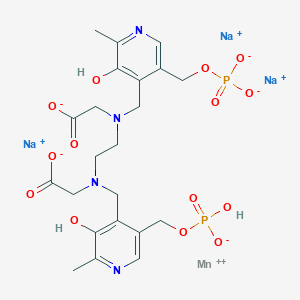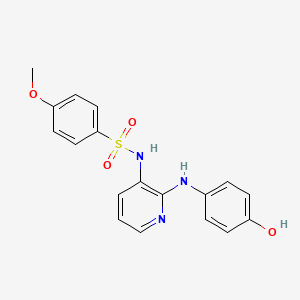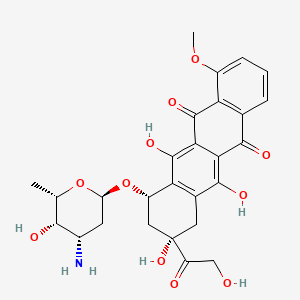
Doxorubicina
Descripción general
Descripción
Doxorubicina, también conocida por su nombre comercial Adriamicina, es un medicamento de quimioterapia que se utiliza para tratar varios tipos de cáncer, incluyendo cáncer de mama, cáncer de vejiga, sarcoma de Kaposi, linfoma y leucemia linfoblástica aguda . Pertenece a la clase de fármacos antraciclínicos y funciona interfiriendo con la función del ADN, inhibiendo en última instancia el crecimiento y la proliferación de las células cancerosas .
Mecanismo De Acción
La doxorubicina ejerce sus efectos intercalcando con el ADN, inhibiendo así la acción de la topoisomerasa II, una enzima involucrada en la replicación del ADN. Esto conduce a la generación de especies reactivas de oxígeno y al subsiguiente daño del ADN, lo que finalmente provoca la muerte celular . La this compound también afecta varios objetivos moleculares y vías, incluida la vía de apoptosis Bcl-2/Bax, que juega un papel crucial en la regulación de la muerte celular .
Compuestos Similares:
- Daunorubicina
- Epirubicina
- Idarubicina
- Mitoxantrona
Comparación: La this compound es única entre estos compuestos debido a su amplio espectro de actividad contra varios tipos de cáncer y su capacidad para intercalar con el ADN. Si bien la daunorubicina es estructuralmente similar a la this compound, tiene una cadena lateral diferente, lo que afecta sus propiedades farmacocinéticas . La epirubicina y la idarubicina también son antraciclinas, pero tienen diferentes perfiles de toxicidad y aplicaciones clínicas . La mitoxantrona, aunque no es una antraciclina, comparte algunas similitudes estructurales y se utiliza en entornos clínicos similares .
En conclusión, la this compound es un agente quimioterapéutico vital con una amplia gama de aplicaciones en investigación científica y medicina. Su mecanismo de acción único y su amplio espectro de actividad la convierten en una herramienta esencial en la lucha contra el cáncer.
Aplicaciones Científicas De Investigación
La doxorubicina tiene una amplia gama de aplicaciones de investigación científica, particularmente en los campos de la química, la biología, la medicina y la industria. En medicina, se utiliza ampliamente como agente quimioterapéutico para tratar varios tipos de cáncer. La investigación se ha centrado en mejorar su eficacia y reducir sus efectos secundarios a través del desarrollo de nuevos sistemas de administración de fármacos como liposomas, nanopartículas y micelas poliméricas .
En biología, la this compound se utiliza para estudiar los mecanismos de daño y reparación del ADN, así como las respuestas celulares al estrés oxidativo. En química, sirve como un compuesto modelo para estudiar las interacciones entre moléculas pequeñas y el ADN .
Análisis Bioquímico
Biochemical Properties
Doxorubicin plays a crucial role in biochemical reactions by interacting with several key biomolecules. It intercalates between DNA base pairs, disrupting the DNA structure and inhibiting the activity of topoisomerase II, an enzyme essential for DNA replication and transcription . This interaction leads to the generation of reactive oxygen species, causing oxidative damage to cellular components . Additionally, doxorubicin binds to various proteins, including histones and transcription factors, further affecting gene expression and cellular function .
Cellular Effects
Doxorubicin exerts profound effects on various types of cells and cellular processes. It induces DNA damage, leading to cell cycle arrest and apoptosis . In cancer cells, doxorubicin triggers the activation of apoptotic pathways, including the Bcl-2/Bax pathway, resulting in programmed cell death . The compound also impairs mitochondrial function, leading to the generation of reactive oxygen species and further promoting cell death . In addition to its cytotoxic effects, doxorubicin influences cell signaling pathways, gene expression, and cellular metabolism, contributing to its overall anticancer activity .
Molecular Mechanism
The molecular mechanism of doxorubicin involves several key processes. Upon entering the cell, doxorubicin intercalates into DNA, disrupting the DNA structure and inhibiting the activity of topoisomerase II . This inhibition prevents the relaxation of supercoiled DNA, leading to the accumulation of DNA breaks and ultimately cell death . Doxorubicin also generates reactive oxygen species, causing oxidative damage to cellular components, including lipids, proteins, and DNA . Furthermore, doxorubicin induces the activation of apoptotic pathways, including the Bcl-2/Bax pathway, resulting in programmed cell death .
Temporal Effects in Laboratory Settings
In laboratory settings, the effects of doxorubicin change over time. The compound is relatively stable, but its efficacy can decrease due to degradation and the development of drug resistance . Long-term exposure to doxorubicin can lead to chronic cardiotoxicity, characterized by mitochondrial dysfunction and oxidative stress . In vitro and in vivo studies have shown that doxorubicin’s cytotoxic effects are time-dependent, with prolonged exposure leading to increased cell death and tissue damage .
Dosage Effects in Animal Models
The effects of doxorubicin vary with different dosages in animal models. At low doses, doxorubicin induces apoptosis in cancer cells without causing significant toxicity to normal tissues . At high doses, doxorubicin can cause severe cardiotoxicity, characterized by mitochondrial damage, oxidative stress, and cell death . Threshold effects have been observed, with a narrow therapeutic window between effective and toxic doses . Studies in animal models have highlighted the importance of dose optimization to minimize adverse effects while maintaining anticancer efficacy .
Metabolic Pathways
Doxorubicin is involved in several metabolic pathways, including one-electron reduction, two-electron reduction, and deglycosidation . The compound is metabolized by enzymes such as cytochrome P450 reductase and aldo-keto reductase, leading to the formation of active and inactive metabolites . These metabolic pathways influence the pharmacokinetics and toxicity of doxorubicin, affecting its overall efficacy and safety . Additionally, doxorubicin can alter metabolic flux and metabolite levels, further impacting cellular function .
Transport and Distribution
Doxorubicin is transported and distributed within cells and tissues through various mechanisms. The compound is taken up by cells via passive diffusion and active transport, involving transporters such as P-glycoprotein . Once inside the cell, doxorubicin is distributed to different organelles, including the nucleus, mitochondria, and lysosomes . The localization and accumulation of doxorubicin within specific cellular compartments influence its cytotoxic effects and overall efficacy .
Subcellular Localization
The subcellular localization of doxorubicin plays a critical role in its activity and function. Doxorubicin primarily localizes to the nucleus, where it intercalates into DNA and inhibits topoisomerase II . Additionally, doxorubicin accumulates in mitochondria, leading to mitochondrial dysfunction and the generation of reactive oxygen species . The compound can also be found in lysosomes, where it contributes to lysosomal membrane permeabilization and cell death . Targeting signals and post-translational modifications may direct doxorubicin to specific compartments, influencing its subcellular distribution and activity .
Métodos De Preparación
Rutas Sintéticas y Condiciones de Reacción: La doxorubicina se sintetiza a partir de la daunorubicina, otro antibiótico antraciclínico. La síntesis implica varios pasos, incluyendo la glicosilación, oxidación y metilación. El intermediario clave en la síntesis es la daunorubicina, que se somete a hidroxilación para formar this compound .
Métodos de Producción Industrial: La producción industrial de this compound generalmente implica la fermentación utilizando la bacteria Streptomyces peucetius. El proceso de fermentación es seguido por pasos de extracción y purificación para aislar la this compound. Las técnicas avanzadas como la carga remota y la PEGilación se utilizan para mejorar la estabilidad y la eficacia de los liposomas de this compound .
Análisis De Reacciones Químicas
Tipos de Reacciones: La doxorubicina sufre varias reacciones químicas, incluyendo la oxidación, reducción y sustitución. Se sabe que se une a las enzimas asociadas al ADN e intercala con los pares de bases del ADN, lo que lleva al daño del ADN .
Reactivos y Condiciones Comunes: Los reactivos comunes utilizados en las reacciones que involucran a la this compound incluyen agentes oxidantes, agentes reductores y varios solventes. Las condiciones para estas reacciones generalmente involucran temperaturas controladas y niveles de pH para asegurar la estabilidad del compuesto .
Principales Productos Formados: Los principales productos formados a partir de las reacciones de la this compound incluyen sus metabolitos, que se excretan a través de la orina y las heces. Estos metabolitos se forman a través de procesos como la hidroxilación y la glicosilación .
Comparación Con Compuestos Similares
- Daunorubicin
- Epirubicin
- Idarubicin
- Mitoxantrone
Comparison: Doxorubicin is unique among these compounds due to its broad spectrum of activity against various cancers and its ability to intercalate with DNA. While daunorubicin is structurally similar to doxorubicin, it has a different side chain, which affects its pharmacokinetic properties . Epirubicin and idarubicin are also anthracyclines but have different toxicity profiles and clinical applications . Mitoxantrone, although not an anthracycline, shares some structural similarities and is used in similar clinical settings .
Propiedades
IUPAC Name |
(7S,9S)-7-[(2R,4S,5S,6S)-4-amino-5-hydroxy-6-methyloxan-2-yl]oxy-6,9,11-trihydroxy-9-(2-hydroxyacetyl)-4-methoxy-8,10-dihydro-7H-tetracene-5,12-dione | |
|---|---|---|
| Source | PubChem | |
| URL | https://pubchem.ncbi.nlm.nih.gov | |
| Description | Data deposited in or computed by PubChem | |
InChI |
InChI=1S/C27H29NO11/c1-10-22(31)13(28)6-17(38-10)39-15-8-27(36,16(30)9-29)7-12-19(15)26(35)21-20(24(12)33)23(32)11-4-3-5-14(37-2)18(11)25(21)34/h3-5,10,13,15,17,22,29,31,33,35-36H,6-9,28H2,1-2H3/t10-,13-,15-,17-,22+,27-/m0/s1 | |
| Source | PubChem | |
| URL | https://pubchem.ncbi.nlm.nih.gov | |
| Description | Data deposited in or computed by PubChem | |
InChI Key |
AOJJSUZBOXZQNB-TZSSRYMLSA-N | |
| Source | PubChem | |
| URL | https://pubchem.ncbi.nlm.nih.gov | |
| Description | Data deposited in or computed by PubChem | |
Canonical SMILES |
CC1C(C(CC(O1)OC2CC(CC3=C2C(=C4C(=C3O)C(=O)C5=C(C4=O)C(=CC=C5)OC)O)(C(=O)CO)O)N)O | |
| Source | PubChem | |
| URL | https://pubchem.ncbi.nlm.nih.gov | |
| Description | Data deposited in or computed by PubChem | |
Isomeric SMILES |
C[C@H]1[C@H]([C@H](C[C@@H](O1)O[C@H]2C[C@@](CC3=C2C(=C4C(=C3O)C(=O)C5=C(C4=O)C(=CC=C5)OC)O)(C(=O)CO)O)N)O | |
| Source | PubChem | |
| URL | https://pubchem.ncbi.nlm.nih.gov | |
| Description | Data deposited in or computed by PubChem | |
Molecular Formula |
C27H29NO11 | |
| Source | PubChem | |
| URL | https://pubchem.ncbi.nlm.nih.gov | |
| Description | Data deposited in or computed by PubChem | |
Related CAS |
25316-40-9 (hydrochloride) | |
| Record name | Doxorubicin [USAN:INN:BAN] | |
| Source | ChemIDplus | |
| URL | https://pubchem.ncbi.nlm.nih.gov/substance/?source=chemidplus&sourceid=0023214928 | |
| Description | ChemIDplus is a free, web search system that provides access to the structure and nomenclature authority files used for the identification of chemical substances cited in National Library of Medicine (NLM) databases, including the TOXNET system. | |
DSSTOX Substance ID |
DTXSID8021480 | |
| Record name | Doxorubicin | |
| Source | EPA DSSTox | |
| URL | https://comptox.epa.gov/dashboard/DTXSID8021480 | |
| Description | DSSTox provides a high quality public chemistry resource for supporting improved predictive toxicology. | |
Molecular Weight |
543.5 g/mol | |
| Source | PubChem | |
| URL | https://pubchem.ncbi.nlm.nih.gov | |
| Description | Data deposited in or computed by PubChem | |
Physical Description |
Solid | |
| Record name | Doxorubicin | |
| Source | Human Metabolome Database (HMDB) | |
| URL | http://www.hmdb.ca/metabolites/HMDB0015132 | |
| Description | The Human Metabolome Database (HMDB) is a freely available electronic database containing detailed information about small molecule metabolites found in the human body. | |
| Explanation | HMDB is offered to the public as a freely available resource. Use and re-distribution of the data, in whole or in part, for commercial purposes requires explicit permission of the authors and explicit acknowledgment of the source material (HMDB) and the original publication (see the HMDB citing page). We ask that users who download significant portions of the database cite the HMDB paper in any resulting publications. | |
Solubility |
Soluble, 2% sol in water; soluble in aqueous alcohols; moderately soluble in anhydrous methanol; insoluble in non-polar organic solvents, 1.18e+00 g/L | |
| Record name | Doxorubicin | |
| Source | DrugBank | |
| URL | https://www.drugbank.ca/drugs/DB00997 | |
| Description | The DrugBank database is a unique bioinformatics and cheminformatics resource that combines detailed drug (i.e. chemical, pharmacological and pharmaceutical) data with comprehensive drug target (i.e. sequence, structure, and pathway) information. | |
| Explanation | Creative Common's Attribution-NonCommercial 4.0 International License (http://creativecommons.org/licenses/by-nc/4.0/legalcode) | |
| Record name | DOXORUBICIN | |
| Source | Hazardous Substances Data Bank (HSDB) | |
| URL | https://pubchem.ncbi.nlm.nih.gov/source/hsdb/3070 | |
| Description | The Hazardous Substances Data Bank (HSDB) is a toxicology database that focuses on the toxicology of potentially hazardous chemicals. It provides information on human exposure, industrial hygiene, emergency handling procedures, environmental fate, regulatory requirements, nanomaterials, and related areas. The information in HSDB has been assessed by a Scientific Review Panel. | |
| Record name | Doxorubicin | |
| Source | Human Metabolome Database (HMDB) | |
| URL | http://www.hmdb.ca/metabolites/HMDB0015132 | |
| Description | The Human Metabolome Database (HMDB) is a freely available electronic database containing detailed information about small molecule metabolites found in the human body. | |
| Explanation | HMDB is offered to the public as a freely available resource. Use and re-distribution of the data, in whole or in part, for commercial purposes requires explicit permission of the authors and explicit acknowledgment of the source material (HMDB) and the original publication (see the HMDB citing page). We ask that users who download significant portions of the database cite the HMDB paper in any resulting publications. | |
Mechanism of Action |
Doxorubicin has antimitotic and cytotoxic activity through a number of proposed mechanisms of action: Doxorubicin forms complexes with DNA by intercalation between base pairs, and it inhibits topoisomerase II activity by stabilizing the DNA-topoisomerase II complex, preventing the religation portion of the ligation-religation reaction that topoisomerase II catalyzes., Doxorubicin hydrochloride is an antineoplastic antibiotic with pharmacologic actions similar to those of daunorubicin. Although the drug has anti-infective properties, its cytotoxicity precludes its use as an anti-infective agent. The precise and/or principal mechanism(s) of the antineoplastic action of doxorubicin is not fully understood. It appears that the cytotoxic effect of the drug results from a complex system of multiple modes of action related to free radical formation secondary to metabolic activation of the doxorubicin by electron reduction, intercalation of the drug into DNA, induction of DNA breaks and chromosomal aberrations, and alterations in cell membranes induced by the drug. Evidence from in vitro studies in cells treated with doxorubicin suggests that apoptosis (programmed cell death) also may be involved in the drug's mechanism of action. These and other mechanisms (chelation of metal ions to produce drug-metal complexes) also may contribute to the cardiotoxic effects of the drug., Doxorubicin undergoes enzymatic 1- and 2-electron reduction to the corresponding semiquinone and dihydroquinone. 7-Deoxyaglycones are formed enzymatically by 1-electron reduction, and the resulting semiquinone free radical reacts with oxygen to produce the hydroxyl radical in a cascade of reactions; this radical may lead to cell death by reacting with DNA, RNA, cell membranes, and proteins. The dihydroquinone that results from 2-electron reduction of doxorubicin also can be formed by the reaction of 2 semiquinones. In the presence of oxygen, dihydroquinone reacts to form hydrogen peroxide, and in its absence, loses its sugar and gives rise to the quinone methide, a monofunctional alkylating agent with low affinity for DNA. The contribution of dihydroquinone and the quinone methide to the cytotoxicity of doxorubicin is unclear. Experimental evidence indicates that doxorubicin forms a complex with DNA by intercalation between base pairs, causing inhibition of DNA synthesis and DNA-dependent RNA synthesis by the resulting template disordering and steric obstruction. Doxorubicin also inhibits protein synthesis. Doxorubicin is active throughout the cell cycle including the interphase., Several anthracycline-induced effects may contribute to the development of cardiotoxicity. In animals, anthracyclines cause a selective inhibition of cardiac muscle gene expression for ?-actin, troponin, myosin light-chain 2, and the M isoform of creatine kinase, which may result in myofibrillar loss associated with anthracycline-induced cardiotoxicity. Other potential causes of anthracycline-induced cardiotoxicity include myocyte damage from calcium overload, altered myocardial adrenergic function, release of vasoactive amines, and proinflammatory cytokines. Limited data indicate that calcium-channel blocking agents (eg, prenylamine) or beta-adrenergic blocking agents may prevent calcium overload ... It has been suggested that the principal cause of anthracycline-induced cardiotoxicity is associated with free radical damage to DNA., Anthracyclines intercalate DNA, chelate metal ions to produce drug-metal complexes, and generate oxygen free radicals via oxidation-reduction reactions. Anthracyclines contain a quinone structure that may undergo reduction via NADPH-dependent reactions to produce a semiquinone free radical that initiates a cascade of oxygen-free radical generation. It appears that the metabolite, doxorubicinol, may be the moiety responsible for cardiotoxic effects, and the heart may be particularly susceptible to free-radical injury because of relatively low antioxidant concentrations. ... Chelation of metal ions, particularly iron, by the drug results in a doxorubicin-metal complex that catalyzes the generation of reactive oxygen free radicals, and the complex is a powerful oxidant that can initiate lipid peroxidation in the absence of oxygen free radicals. This reaction is not blocked by free-radical scavengers, and probably is the principal mechanism of anthracycline-induced cardiotoxicity., The effect of doxorubicin on reactive oxygen metb in rat heart was investigated. It produced oxygen radicals in heart homogenate, sarcoplasmic reticulum, mitochondria, and cytosol, the major sites of cardiac damage. Superoxide prodn in heart sarcosomes and the mitochondrial fraction was incr. Apparently, free radical formation by doxorubicin, which occurs in the same myocardial compartments that are subject to drug-induced tissue injury, may damage the heart by exceeding the oxygen radical detoxifying capacity of cardiac mitochondria and sarcoplasmic reticulum. | |
| Record name | Doxorubicin | |
| Source | DrugBank | |
| URL | https://www.drugbank.ca/drugs/DB00997 | |
| Description | The DrugBank database is a unique bioinformatics and cheminformatics resource that combines detailed drug (i.e. chemical, pharmacological and pharmaceutical) data with comprehensive drug target (i.e. sequence, structure, and pathway) information. | |
| Explanation | Creative Common's Attribution-NonCommercial 4.0 International License (http://creativecommons.org/licenses/by-nc/4.0/legalcode) | |
| Record name | DOXORUBICIN | |
| Source | Hazardous Substances Data Bank (HSDB) | |
| URL | https://pubchem.ncbi.nlm.nih.gov/source/hsdb/3070 | |
| Description | The Hazardous Substances Data Bank (HSDB) is a toxicology database that focuses on the toxicology of potentially hazardous chemicals. It provides information on human exposure, industrial hygiene, emergency handling procedures, environmental fate, regulatory requirements, nanomaterials, and related areas. The information in HSDB has been assessed by a Scientific Review Panel. | |
Impurities |
(8S,10S)-10[(3-amino-2,3,6-trideoxy-alpha-levo-lyxo-hexopyranosyl)oxy]-8-(2-bromo-1,1-dimethoxyethyl)-6,8,11-trihydroxy-1-methoxy-7,8,9,10-tetrahydrotetracene-5,12-dione, (8S,10S)-10[(3-amino-2,3,6-trideoxy-alpha-levo-lyxo-hexopyranosyl)oxy]-8-(bromoacetyl)-6,8,11-trihydroxy-1-methoxy-7,8,9,10-tetrahydrotetracene-5,12-dione, Daunorubicin, Doxorubicinone | |
| Record name | DOXORUBICIN | |
| Source | Hazardous Substances Data Bank (HSDB) | |
| URL | https://pubchem.ncbi.nlm.nih.gov/source/hsdb/3070 | |
| Description | The Hazardous Substances Data Bank (HSDB) is a toxicology database that focuses on the toxicology of potentially hazardous chemicals. It provides information on human exposure, industrial hygiene, emergency handling procedures, environmental fate, regulatory requirements, nanomaterials, and related areas. The information in HSDB has been assessed by a Scientific Review Panel. | |
Color/Form |
Red, crystalline solid | |
CAS No. |
23214-92-8 | |
| Record name | Doxorubicin | |
| Source | CAS Common Chemistry | |
| URL | https://commonchemistry.cas.org/detail?cas_rn=23214-92-8 | |
| Description | CAS Common Chemistry is an open community resource for accessing chemical information. Nearly 500,000 chemical substances from CAS REGISTRY cover areas of community interest, including common and frequently regulated chemicals, and those relevant to high school and undergraduate chemistry classes. This chemical information, curated by our expert scientists, is provided in alignment with our mission as a division of the American Chemical Society. | |
| Explanation | The data from CAS Common Chemistry is provided under a CC-BY-NC 4.0 license, unless otherwise stated. | |
| Record name | Doxorubicin [USAN:INN:BAN] | |
| Source | ChemIDplus | |
| URL | https://pubchem.ncbi.nlm.nih.gov/substance/?source=chemidplus&sourceid=0023214928 | |
| Description | ChemIDplus is a free, web search system that provides access to the structure and nomenclature authority files used for the identification of chemical substances cited in National Library of Medicine (NLM) databases, including the TOXNET system. | |
| Record name | Doxorubicin | |
| Source | DrugBank | |
| URL | https://www.drugbank.ca/drugs/DB00997 | |
| Description | The DrugBank database is a unique bioinformatics and cheminformatics resource that combines detailed drug (i.e. chemical, pharmacological and pharmaceutical) data with comprehensive drug target (i.e. sequence, structure, and pathway) information. | |
| Explanation | Creative Common's Attribution-NonCommercial 4.0 International License (http://creativecommons.org/licenses/by-nc/4.0/legalcode) | |
| Record name | Doxorubicin | |
| Source | EPA DSSTox | |
| URL | https://comptox.epa.gov/dashboard/DTXSID8021480 | |
| Description | DSSTox provides a high quality public chemistry resource for supporting improved predictive toxicology. | |
| Record name | Doxorubicin | |
| Source | European Chemicals Agency (ECHA) | |
| URL | https://echa.europa.eu/substance-information/-/substanceinfo/100.041.344 | |
| Description | The European Chemicals Agency (ECHA) is an agency of the European Union which is the driving force among regulatory authorities in implementing the EU's groundbreaking chemicals legislation for the benefit of human health and the environment as well as for innovation and competitiveness. | |
| Explanation | Use of the information, documents and data from the ECHA website is subject to the terms and conditions of this Legal Notice, and subject to other binding limitations provided for under applicable law, the information, documents and data made available on the ECHA website may be reproduced, distributed and/or used, totally or in part, for non-commercial purposes provided that ECHA is acknowledged as the source: "Source: European Chemicals Agency, http://echa.europa.eu/". Such acknowledgement must be included in each copy of the material. ECHA permits and encourages organisations and individuals to create links to the ECHA website under the following cumulative conditions: Links can only be made to webpages that provide a link to the Legal Notice page. | |
| Record name | DOXORUBICIN | |
| Source | FDA Global Substance Registration System (GSRS) | |
| URL | https://gsrs.ncats.nih.gov/ginas/app/beta/substances/80168379AG | |
| Description | The FDA Global Substance Registration System (GSRS) enables the efficient and accurate exchange of information on what substances are in regulated products. Instead of relying on names, which vary across regulatory domains, countries, and regions, the GSRS knowledge base makes it possible for substances to be defined by standardized, scientific descriptions. | |
| Explanation | Unless otherwise noted, the contents of the FDA website (www.fda.gov), both text and graphics, are not copyrighted. They are in the public domain and may be republished, reprinted and otherwise used freely by anyone without the need to obtain permission from FDA. Credit to the U.S. Food and Drug Administration as the source is appreciated but not required. | |
| Record name | DOXORUBICIN | |
| Source | Hazardous Substances Data Bank (HSDB) | |
| URL | https://pubchem.ncbi.nlm.nih.gov/source/hsdb/3070 | |
| Description | The Hazardous Substances Data Bank (HSDB) is a toxicology database that focuses on the toxicology of potentially hazardous chemicals. It provides information on human exposure, industrial hygiene, emergency handling procedures, environmental fate, regulatory requirements, nanomaterials, and related areas. The information in HSDB has been assessed by a Scientific Review Panel. | |
| Record name | Doxorubicin | |
| Source | Human Metabolome Database (HMDB) | |
| URL | http://www.hmdb.ca/metabolites/HMDB0015132 | |
| Description | The Human Metabolome Database (HMDB) is a freely available electronic database containing detailed information about small molecule metabolites found in the human body. | |
| Explanation | HMDB is offered to the public as a freely available resource. Use and re-distribution of the data, in whole or in part, for commercial purposes requires explicit permission of the authors and explicit acknowledgment of the source material (HMDB) and the original publication (see the HMDB citing page). We ask that users who download significant portions of the database cite the HMDB paper in any resulting publications. | |
Melting Point |
229-231 °C, 230 °C, MELTING POINT: 205 °C WITH DECOMP; PKA: 8.22; ALMOST ODORLESS; HYGROSCOPIC /HYDROCHLORIDE/, 204 - 205 °C | |
| Record name | Doxorubicin | |
| Source | DrugBank | |
| URL | https://www.drugbank.ca/drugs/DB00997 | |
| Description | The DrugBank database is a unique bioinformatics and cheminformatics resource that combines detailed drug (i.e. chemical, pharmacological and pharmaceutical) data with comprehensive drug target (i.e. sequence, structure, and pathway) information. | |
| Explanation | Creative Common's Attribution-NonCommercial 4.0 International License (http://creativecommons.org/licenses/by-nc/4.0/legalcode) | |
| Record name | DOXORUBICIN | |
| Source | Hazardous Substances Data Bank (HSDB) | |
| URL | https://pubchem.ncbi.nlm.nih.gov/source/hsdb/3070 | |
| Description | The Hazardous Substances Data Bank (HSDB) is a toxicology database that focuses on the toxicology of potentially hazardous chemicals. It provides information on human exposure, industrial hygiene, emergency handling procedures, environmental fate, regulatory requirements, nanomaterials, and related areas. The information in HSDB has been assessed by a Scientific Review Panel. | |
| Record name | Doxorubicin | |
| Source | Human Metabolome Database (HMDB) | |
| URL | http://www.hmdb.ca/metabolites/HMDB0015132 | |
| Description | The Human Metabolome Database (HMDB) is a freely available electronic database containing detailed information about small molecule metabolites found in the human body. | |
| Explanation | HMDB is offered to the public as a freely available resource. Use and re-distribution of the data, in whole or in part, for commercial purposes requires explicit permission of the authors and explicit acknowledgment of the source material (HMDB) and the original publication (see the HMDB citing page). We ask that users who download significant portions of the database cite the HMDB paper in any resulting publications. | |
Retrosynthesis Analysis
AI-Powered Synthesis Planning: Our tool employs the Template_relevance Pistachio, Template_relevance Bkms_metabolic, Template_relevance Pistachio_ringbreaker, Template_relevance Reaxys, Template_relevance Reaxys_biocatalysis model, leveraging a vast database of chemical reactions to predict feasible synthetic routes.
One-Step Synthesis Focus: Specifically designed for one-step synthesis, it provides concise and direct routes for your target compounds, streamlining the synthesis process.
Accurate Predictions: Utilizing the extensive PISTACHIO, BKMS_METABOLIC, PISTACHIO_RINGBREAKER, REAXYS, REAXYS_BIOCATALYSIS database, our tool offers high-accuracy predictions, reflecting the latest in chemical research and data.
Strategy Settings
| Precursor scoring | Relevance Heuristic |
|---|---|
| Min. plausibility | 0.01 |
| Model | Template_relevance |
| Template Set | Pistachio/Bkms_metabolic/Pistachio_ringbreaker/Reaxys/Reaxys_biocatalysis |
| Top-N result to add to graph | 6 |
Feasible Synthetic Routes
Descargo de responsabilidad e información sobre productos de investigación in vitro
Tenga en cuenta que todos los artículos e información de productos presentados en BenchChem están destinados únicamente con fines informativos. Los productos disponibles para la compra en BenchChem están diseñados específicamente para estudios in vitro, que se realizan fuera de organismos vivos. Los estudios in vitro, derivados del término latino "in vidrio", involucran experimentos realizados en entornos de laboratorio controlados utilizando células o tejidos. Es importante tener en cuenta que estos productos no se clasifican como medicamentos y no han recibido la aprobación de la FDA para la prevención, tratamiento o cura de ninguna condición médica, dolencia o enfermedad. Debemos enfatizar que cualquier forma de introducción corporal de estos productos en humanos o animales está estrictamente prohibida por ley. Es esencial adherirse a estas pautas para garantizar el cumplimiento de los estándares legales y éticos en la investigación y experimentación.



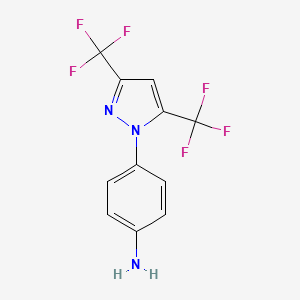
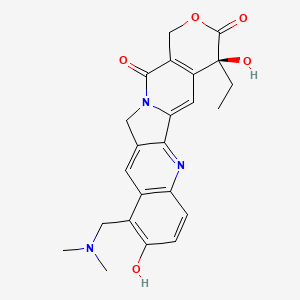
![3-[4-[2-[[6-amino-9-[(2R,3R,4S,5S)-5-(ethylcarbamoyl)-3,4-dihydroxyoxolan-2-yl]purin-2-yl]amino]ethyl]phenyl]propanoic acid;hydrochloride](/img/structure/B1662843.png)
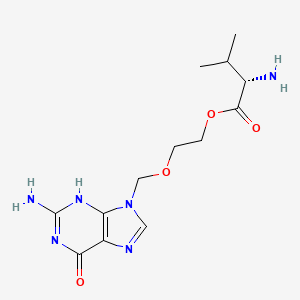
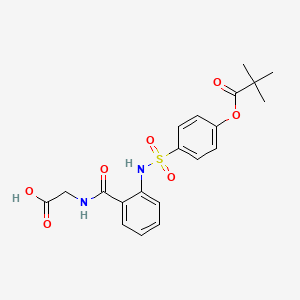
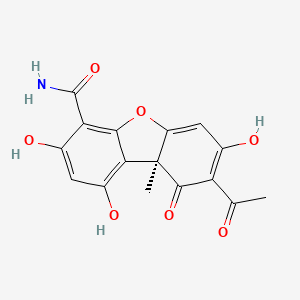
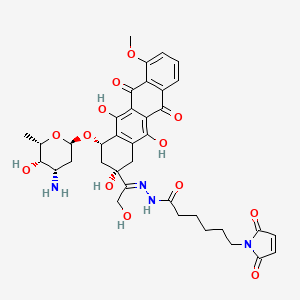

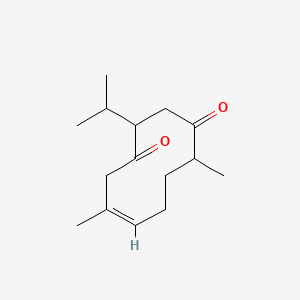
![(6S)-1-[[4-(dimethylamino)-3-methylphenyl]methyl]-5-(2,2-diphenylacetyl)-6,7-dihydro-4H-imidazo[4,5-c]pyridine-6-carboxylic acid;2,2,2-trifluoroacetic acid](/img/structure/B1662854.png)
![(E)-N-ethyl-6,6-dimethyl-N-[[3-[(4-thiophen-3-ylthiophen-2-yl)methoxy]phenyl]methyl]hept-2-en-4-yn-1-amine;hydrochloride](/img/structure/B1662855.png)
